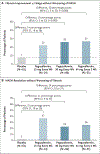Randomized, Controlled Trial of the FGF21 Analogue Pegozafermin in NASH
- PMID: 37356033
- PMCID: PMC10718287
- DOI: 10.1056/NEJMoa2304286
Randomized, Controlled Trial of the FGF21 Analogue Pegozafermin in NASH
Abstract
Background: Pegozafermin is a long-acting glycopegylated (pegylated with the use of site-specific glycosyltransferases) fibroblast growth factor 21 (FGF21) analogue in development for the treatment of nonalcoholic steatohepatitis (NASH) and severe hypertriglyceridemia. The efficacy and safety of pegozafermin in patients with biopsy-proven noncirrhotic NASH are not well established.
Methods: In this phase 2b, multicenter, double-blind, 24-week, randomized, placebo-controlled trial, we randomly assigned patients with biopsy-confirmed NASH and stage F2 or F3 (moderate or severe) fibrosis to receive subcutaneous pegozafermin at a dose of 15 mg or 30 mg weekly or 44 mg once every 2 weeks or placebo weekly or every 2 weeks. The two primary end points were an improvement in fibrosis (defined as reduction by ≥1 stage, on a scale from 0 to 4, with higher stages indicating greater severity), with no worsening of NASH, at 24 weeks and NASH resolution without worsening of fibrosis at 24 weeks. Safety was also assessed.
Results: Among the 222 patients who underwent randomization, 219 received pegozafermin or placebo. The percentage of patients who met the criteria for fibrosis improvement was 7% in the pooled placebo group, 22% in the 15-mg pegozafermin group (difference vs. placebo, 14 percentage points; 95% confidence interval [CI], -9 to 38), 26% in the 30-mg pegozafermin group (difference, 19 percentage points; 95% CI, 5 to 32; P = 0.009), and 27% in the 44-mg pegozafermin group (difference, 20 percentage points; 95% CI, 5 to 35; P = 0.008). The percentage of patients who met the criteria for NASH resolution was 2% in the placebo group, 37% in the 15-mg pegozafermin group (difference vs. placebo, 35 percentage points; 95% CI, 10 to 59), 23% in the 30-mg pegozafermin group (difference, 21 percentage points; 95% CI, 9 to 33), and 26% in the 44-mg pegozafermin group (difference, 24 percentage points; 95% CI, 10 to 37). The most common adverse events associated with pegozafermin therapy were nausea and diarrhea.
Conclusions: In this phase 2b trial, treatment with pegozafermin led to improvements in fibrosis. These results support the advancement of pegozafermin into phase 3 development. (Funded by 89bio; ENLIVEN ClinicalTrials.gov number, NCT04929483.).
Copyright © 2023 Massachusetts Medical Society.
Figures

Comment in
-
Randomized Trial of Pegozafermin in NASH.N Engl J Med. 2023 Dec 7;389(23):2209-2210. doi: 10.1056/NEJMc2311873. N Engl J Med. 2023. PMID: 38055265 No abstract available.
-
Randomized Trial of Pegozafermin in NASH. Reply.N Engl J Med. 2023 Dec 7;389(23):2210. doi: 10.1056/NEJMc2311873. N Engl J Med. 2023. PMID: 38055266 No abstract available.
References
-
- Loomba R, Friedman SL, Shulman GI. Mechanisms and disease consequences of nonalcoholic fatty liver disease. Cell 2021; 184:2537–64. - PubMed
-
- Younossi ZM, Koenig AB, Abdelatif D, Fazel Y, Henry L, Wymer M. Global epidemiology of nonalcoholic fatty liver disease-Meta-analytic assessment of prevalence, incidence, and outcomes. Hepatology 2016; 64:73–84. - PubMed
Publication types
MeSH terms
Substances
Associated data
Grants and funding
LinkOut - more resources
Full Text Sources
Other Literature Sources
Medical
Miscellaneous
